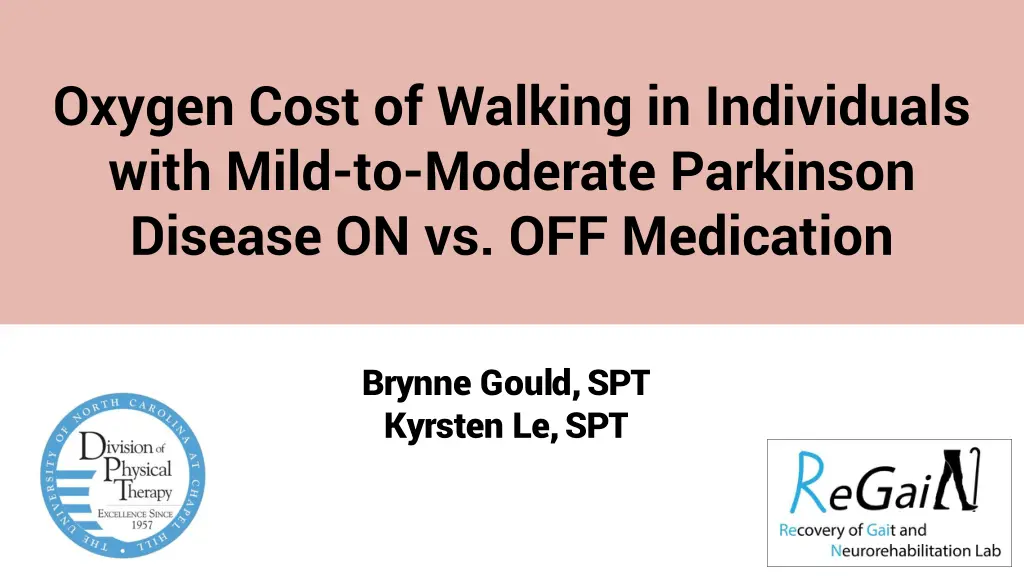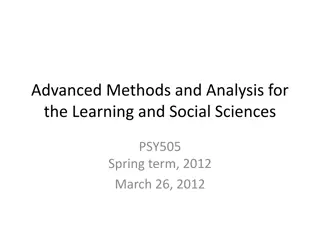
Effect of Dopaminergic Medication on Oxygen Cost of Walking in Parkinson's Disease
Explore the impact of dopaminergic medication on gait and metabolic cost in individuals with Parkinson's disease. Understand the potential benefits of medication on gait efficiency and oxygen consumption. Dive into the relationship between medication and spatiotemporal parameters of walking in Parkinson's patients.
Download Presentation

Please find below an Image/Link to download the presentation.
The content on the website is provided AS IS for your information and personal use only. It may not be sold, licensed, or shared on other websites without obtaining consent from the author. If you encounter any issues during the download, it is possible that the publisher has removed the file from their server.
You are allowed to download the files provided on this website for personal or commercial use, subject to the condition that they are used lawfully. All files are the property of their respective owners.
The content on the website is provided AS IS for your information and personal use only. It may not be sold, licensed, or shared on other websites without obtaining consent from the author.
E N D
Presentation Transcript
Oxygen Cost of Walking in Individuals with Mild-to-Moderate Parkinson Disease ON vs. OFF Medication Brynne Gould, SPT Kyrsten Le, SPT
Parkinson disease (PD) PD is the second most common diagnosed neurodegenerative disease in North America (Willis 2022) Motor symptoms of PD result in gait disturbances that impact functional mobility and independence. (Kim 2018, Hausdorff 2009, Zanardi 2021) Symptoms Gait Impairments (Hausdorff 2009) Bradykinesia Hypokinesia Rigidity Tremor Postural Instability Decreased gait speed Shorter stride length Reduced trunk and limb movement Increased falls risk and decreased participation
Oxygen Cost of Walking Gait impairments increased oxygen cost of walking or worse walking economy (Jeng 2020; Buoite 2020; Serra 2016) People with mild-to-moderate PD demonstrate a higher metabolic cost of walking during overground walking compared to healthy controls (Jeng 2020) Buoite 2020, Serra 2016, Padmanabhan 2021
PD Treatment - Dopaminergic Medication Dopaminergic medications aim to increase dopamine levels in the brain to address motor symptoms of PD Medication has a mixed effect regarding the alleviation of gait disturbances in people with PD (Smulders 2016; Avila de Oliveira 2021)
Previous Literature Limited understanding regarding the potential effect of dopaminergic medication on walking economy in people with PD More recent evidence suggests that dopaminergic medication may not influence metabolic cost of walking when walking at a constant speed on a treadmill (Padmanabhan 2021)
Purpose: Hypothesis: To determine the effect of dopaminergic medications on metabolic cost and gait in people with PD when walking overground We hypothesized that dopaminergic medication will have a beneficial impact on spatiotemporal parameters of gait; therefore, people with PD will exhibit more efficient gait that decreases oxygen consumption
Research Questions What is the effect of dopaminergic medication on oxygen cost of walking? 1 What is the effect of dopaminergic medication on spatiotemporal parameters of gait? 2 What is the effect of dopaminergic medication on endurance? 3 What is the relationship between changes in spatiotemporal parameters of gait and changes in oxygen cost of walking? 4
Design Demographic Information Collected Resting Oxygen Consumption (Seated) 6MWT with COSMED - OFF Meds Resting Oxygen Consumption (Seated) 6MWT with COSMED - ON Meds Participants come to lab OFF medication for at least 12 hours Participants take dopaminergic medication
Participants Exclusion Criteria Receiving physical therapy DBS surgery Uncontrolled cardiorespiratory or metabolic disease Presence of other neurological conditions Orthopedic injury that impacts gait Subject Height Weight Chronicity HY MDS UPDRS 5'9 145 9 years 2 21 1 5'3 100 4 years 2 36 2 5'8 180 Not Reported 2 26 3 6'1 230 5 years 2 21 4 5'7 203 2 years 2 28 5 5'6 130 3 years 2 22 6 5'7 113 2 years 2 20 7 Data Analysis 5'8 212 7 years 1 Not Reported 8 Mann-Whitney U test Spearman correlation analysis
Measures Distance per minute on 6MWT Total distance on 6MWT Endurance Index Resting oxygen consumption Oxygen Cost of Walking (mL/kg/m) Metabolic power Spatiotemporal parameters of gait including: Stride length Step width Cadence Gait speed
1 Effect of Dopaminergic Medication on Metabolic Cost of Walking No significant difference between oxygen cost of walking ON versus OFF medication walking overground at a self-selected speed OFF Medication ON Medication P-Value Median = 4.37 IQR = 1.82 Median = 4.17 IQR = 2.24 P = 0.575 Metabolic Cost of Walking
1 Effect of Dopaminergic Medication on Metabolic Cost of Walking
2 Effect of Dopaminergic Medication on Spatiotemporal Parameters of Gait OFF Medication ON Medication P-Value Median = 1.45 IQR = 0.28 Median = 1.44 IQR = 0.21 P = 0.123 Gait Speed No significant difference between spatiotemporal parameters of gait ON versus OFF medication Median = 135.66 IQR = 18.57 Median = 141.40 IQR = 17.40 P = 0.674 Stride Length Median = 118.76 IQR = 26.49 Median =119.36 IQR = 19.28 P = 0.161 Cadence Median = 8.68 IQR = 3.79 Median = 9.28 IQR = 5.69 P = 0.161 Step Width
Effect of Dopaminergic Medication on Spatiotemporal Parameters of Gait 2
3 Effect of Dopaminergic Medication on Endurance There was no significant difference between total distance traveled during the 6MWT ON versus OFF medication. There was no significant difference between endurance index ON versus OFF medication. OFF Medication ON Medication P-Value Median = 1,609.5 IQR = 311 Median = 1,635 IQR = 297 P = 0.161 Total Distance During 6MWT Median = 1.04 IQR = 0.13 Median = 0.98 IQR = 0.10 P = 0.123 Endurance Index
3 Effect of Dopaminergic Medication on Endurance
4 Correlation Between Changes in Oxygen Cost of Walking and Changes in Spatiotemporal Parameters of Gait Change in gait speed was significantly and strongly associated with change in stride length.
Correlation Between Change in Stride Length and Change in Gait Speed
Our results do not support our original hypothesis. These results add to the body of knowledge that dopaminergic medication may not consistently impact spatiotemporal measures of gait in the short- term. PTs and physicians should not rely on medication alone to provide improvements in gait and walking economy. These results highlight the importance of aerobic exercise and gait training.
Limitations Small sample size Majority of participants H&Y 2 Lack of ability to standardize dyskinesia






















